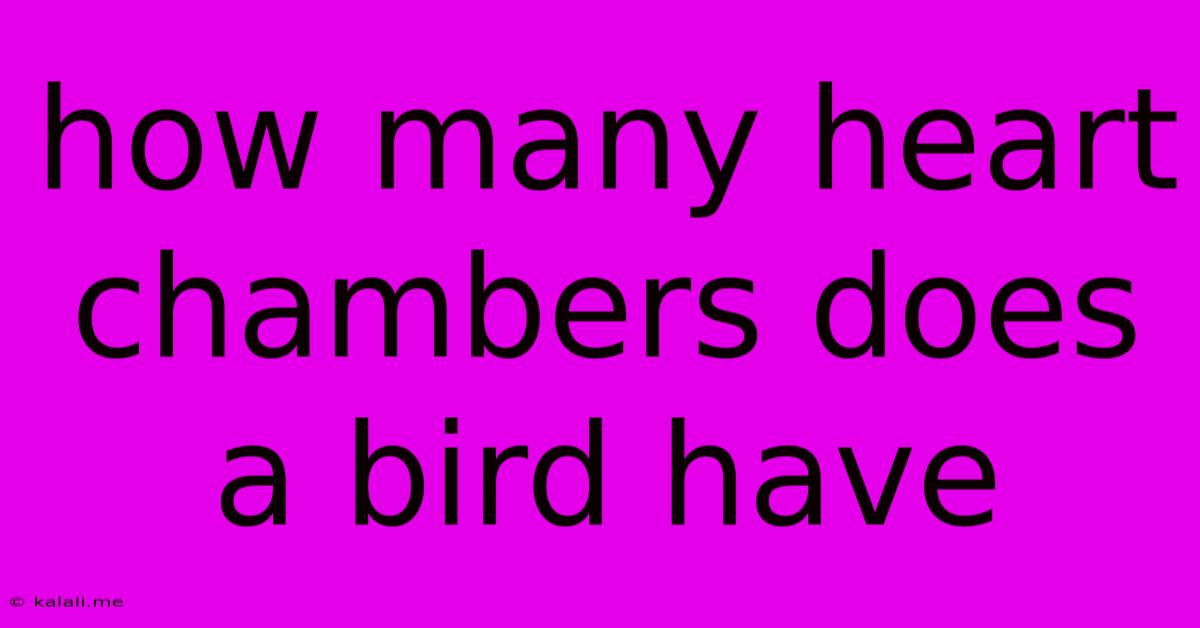How Many Heart Chambers Does A Bird Have
Kalali
May 09, 2025 · 3 min read

Table of Contents
How Many Heart Chambers Does a Bird Have? A Deep Dive into Avian Cardiology
Birds, with their incredible ability to fly and their vibrant plumage, often fascinate us. But have you ever wondered about the intricacies of their internal systems? One such fascinating aspect is their cardiovascular system, specifically, the number of chambers in their heart. This article will explore the avian heart, its structure, and why it's uniquely adapted for flight.
Understanding the Avian Heart: Four Chambers for Flight
The short answer is: birds have four chambers in their heart – two atria and two ventricles. This is similar to the human heart, and crucially different from the three-chambered hearts found in reptiles (excluding crocodilians, which also have four). This four-chambered structure is vital for the high metabolic demands of flight.
Why Four Chambers are Essential for Birds
The four-chambered heart is incredibly efficient at separating oxygenated and deoxygenated blood. This separation prevents mixing, ensuring that the bird's muscles receive a constant supply of oxygen-rich blood. This is critical for powering the strenuous activity of flight, which requires a significant amount of energy. Let's break down the importance:
-
Efficient Oxygen Delivery: The two atria receive blood, with the right atrium receiving deoxygenated blood from the body and the left atrium receiving oxygenated blood from the lungs. The two ventricles then pump this blood; the right ventricle pumping deoxygenated blood to the lungs for oxygenation, and the left ventricle pumping oxygenated blood to the rest of the body. This efficient system ensures maximum oxygen delivery to the muscles.
-
High Metabolic Rate: Birds have exceptionally high metabolic rates, especially during flight. This high rate requires a constant and robust supply of oxygen to fuel their muscles. The four-chambered heart is perfectly adapted to meet this demand.
-
Endothermy: Birds are endothermic, meaning they regulate their own body temperature. Maintaining a constant body temperature requires a significant amount of energy, which is facilitated by the efficient oxygen delivery provided by their four-chambered heart.
Comparing Avian and Mammalian Hearts
While both birds and mammals possess four-chambered hearts, there are some subtle differences. For instance, the structure and size of the heart chambers can vary depending on the bird's size and flight style. Birds of prey, for example, often have larger hearts relative to their body size compared to ground-dwelling birds.
Evolutionary Significance
The evolution of the four-chambered heart in birds is a significant milestone in vertebrate evolution. This development allowed for a higher level of metabolic activity and paved the way for the evolution of flight. The increased efficiency of oxygen transport played a crucial role in enabling birds to conquer the skies.
Beyond the Heart Chambers: Other Adaptations for Flight
The four-chambered heart is just one part of the avian cardiovascular system that is superbly adapted to flight. Other adaptations include:
- High Heart Rate: Birds typically have much higher heart rates than mammals of comparable size.
- Efficient Respiratory System: Birds also possess a highly efficient respiratory system with air sacs that provide a continuous flow of oxygen-rich air through their lungs.
In conclusion, the four-chambered heart is a key feature of avian physiology, allowing birds to achieve the high metabolic rates necessary for flight and maintain their endothermic lifestyle. This remarkable adaptation underscores the intricate and fascinating nature of avian biology.
Latest Posts
Related Post
Thank you for visiting our website which covers about How Many Heart Chambers Does A Bird Have . We hope the information provided has been useful to you. Feel free to contact us if you have any questions or need further assistance. See you next time and don't miss to bookmark.